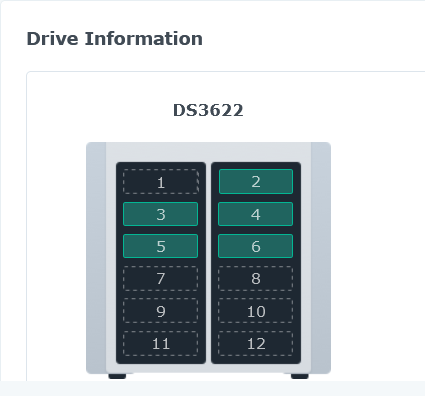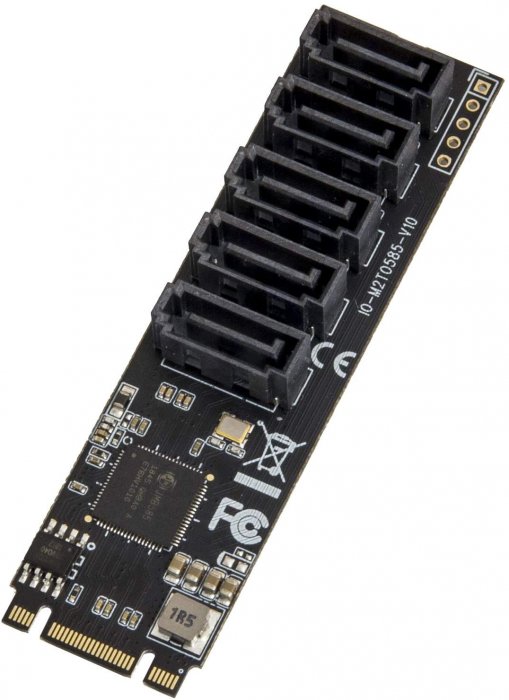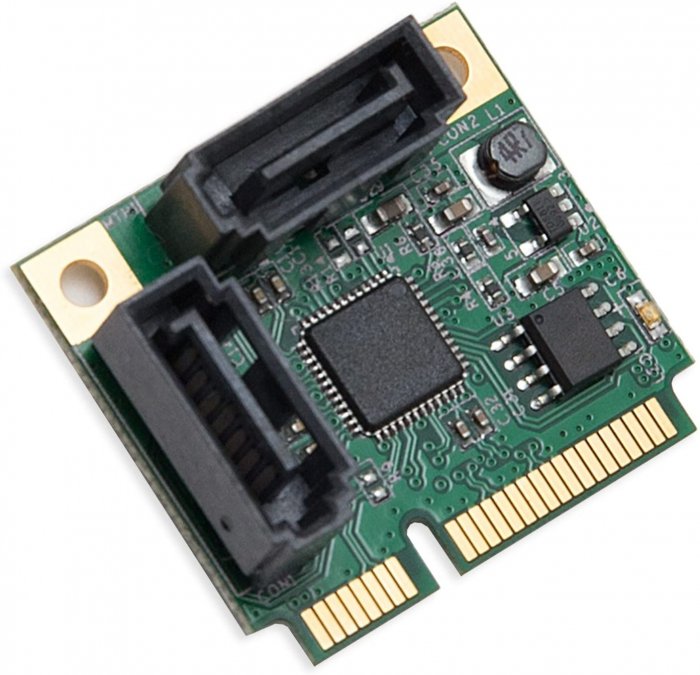-
Posts
398 -
Joined
-
Last visited
-
Days Won
3
Everything posted by phone guy
-

Advanced Media Extension will not activate dsm7.1-42661
phone guy replied to phone guy's topic in Synology Packages
I think it has been mentioned here, that some S/N may be blocked by Synology, so I would assume if the serial (generated or real) is blocked or not blocked that may be contributing factor in success or failure. -
Try in Chrome. I tried to use firefox with my genuine synology nas and had issues, when you click synology account in control panel in chrome. the page loads correctly. That fixed it for me. [rant] honestly, while I do not like chrome, I prefer firefox, chrome seems to get along better with DSM. Thats been my experience, maybe my firefox is messed up? I dunno [/rant]
-
Honestly having the satamap checkscsi acknowledge the existence of the HBA is useful, and will probably help more than hurt, as the example above illustrates. Just with the understanding by users the args in user_config.json are not influencing the HBA... Thats my opinion no one asked for
-
Whats wrong with Active backup for business? its windows and linux only no mac yet, but its included in dsm and seems to work. Though I have never had to actually restore anything as yet.
-
There were a couple of things posted that were miscommunications unfortunately. I do not do that 4 string command to clean and remove files and folders from the loader after its complete, I guess some do...? I leave everything in there in case I need to add a ext driver and re build the loader and I didn't think you were blaming me. I always try to help when I can! I Try to take some of load off all of your shoulders in the forums for you guys. 👍 if I know the answer or think I can help, I try to interact and help.
-
You are limited to only the DS3622xs+ which is the most current for dsm7.1 and runs on that hardware. The other models require 4th intel (haswell) or better, so your choice is easy. Use and read flyrides tutorial. He explains everything and you will be up and running in no time. Or check my signture and you can use Proxmox too
-
Because I use specific sn/macs on my builds, I keep track of them, and I notice that the user_config gets replaced with default during the updates. Thats why I warned him of that... I personally use update, fullupgrade then the rest of the commands, and just before building I edit the user_config.json if needed then I build the loader. I may not have known restoresession was an option? I dont know. I know it asks at some point do you want to use files found in old, and (for me) that didnt work it seems to start with the default config. It may have been user error by me - I admit that. Its a simple step to just verify the config before building. I also keep a local copy of my configs too. Just trying to help out
-
The user config gets replaced when you clean, update or fullupgrade. So run those first and after you've got your TCRP fully updated, you can manually edit your user_config.json before doing the build command. This tutorial has everything you need to sort your issue
-
I mention above this is not the only way to get redpill working in proxmox, its the way I get redpill working in proxmox. And because there was no easy english tutorial with pictures to follow I wrote this to help others. This method is more like a baremetal build IMHO. As for ext drivers, acpid works on some but not all platforms depending on repo source, but all ext seem to change almost regularly, the guys keeping this whole project running are working constantly to improve, mod, tweak the experience. fixing things as they are reported, updating things as needed so everyones individual results will vary slightly depending on current status of project and those ext's and individual hardware and use case, another reason VM is desirable as its results are more easily reproducible, following each step correctly. 😉 As for the tutorial @flyride created a great tutorial explaining in detail the process of building the loader.
-
OH!? I did not even try it, as I am waiting until the .dts/dtb process for 920/1621 models improves - that was my big wish for jun mode, improved (automated) dts/dtb creation. So still no successful builds with tcrp + juns mode. Sorry to hear that, I thought it was working....
-
Wait, to be clear, you guys are saying by building a 7.0-42218 loader using @jumkey juns old tricks loader you can simply upgrade from a 7.0 build to 7.1 build like a genuine syno-box (this I knew). But are we sure it will would take the next upgrade? I did not run Jun 104b dsm623 for long at all before joining the redpill faithful And I am assuming to use the jumkey juns old tricks buildroot method you have to be on q35 in proxmox?
-
Is anyone else have trouble backing up to a xpenology redpill machine? I have a couple of genuine synology nas, using hyperbackup between them is fine... trying to go genuine syno -> xpen-syno via hyperbackup always seems to fail, or data doesnt check out, or fills up destination? always an error of some kind. I have had this happen on baremetal xpen and vm xpen (redpill dsm7.1) anyone else?
-
Depends on your loader, safest bet would be to rebuild for yourplatform 42661.
-
I only tested building the dva3221, so I can not verify that all 8 licenses in fact work, but @alexsahka is correct, using the serial gen as he described will add both serial and mac to your user config before building. I did not have to remove internet access in my test build, but SS did report as having all 8 licenses available to me.
-
Have him try the v9fs driver for the dva3221. AFAIK its everything Virtio is + more so it should work. ./rploader.sh ext denverton-7.0.1-42218 add https://raw.githubusercontent.com/pocopico/rp-ext/master/v9fs/rpext-index.json ./rploader.sh ext denverton-7.1.0-42661 add https://raw.githubusercontent.com/pocopico/rp-ext/master/v9fs/rpext-index.json
-
Admittedly I am a little lost and confused by this patch... If I am understanding right, it will help auto populate hdd positions (slots) when building ds920 and ds1621 loaders? so there will be no need for users to manually map drive positions or slots first? if I am right, does it do this each boot? or once the loader is created its maps all available ports so hot swap hdd will still work? or am I completely wrong?
-

KVM and SATAMAP testing with RedPill - discoveries
phone guy replied to flyride's topic in Developer Discussion Room
Just for the record, on rploader 0714 on this same system doing satamap used to load (before) a little application and saw 3 SATA controllers before. 2 from proxmox and the last being the hba itself. This time it only saw 1 data controller and it was not the hba. Just getting you know 👍 -

KVM and SATAMAP testing with RedPill - discoveries
phone guy replied to flyride's topic in Developer Discussion Room
Not sure what was improved or changed, but build a new VM as Q35 (whatever the latest version in proxmox is). Set pci pass thru of hba like before, create fresh new loader, rploader os 0.7.1.6 - however disks on HBA still start at slot #2. These are the only drives in that system all physical. nothing emu. ./rploader.sh update now ./rploader.sh fullupgrade now ./rploader.sh satamap now ./rploader.sh ext broadwellnk-7.1.0-42661 add https://raw.githubusercontent.com/dodo-dk/rp-ext/main/acpid/rpext-index.json ./rploader.sh ext broadwellnk-7.1.0-42661 add https://raw.githubusercontent.com/pocopico/rp-ext/master/v9fs/rpext-index.json ./rploader.sh ext broadwellnk-7.1.0-42661 add https://raw.githubusercontent.com/pocopico/rp-ext/master/mpt3sas/rpext-index.json ./rploader.sh build broadwellnk-7.1.0-42661 ./rploader.sh clean now; rm -rf /mnt/sdb3/auxfiles; rm -rf /home/tc/custom-module; ./rploader.sh backup now; -
Anyone with experience have any suggestions for a Mini ITX board and chip combo that is going to live its life as an 8 bay hotswappable xpenology box? I would like the option to add a graphics card in case it becomes a DVA3221, but thats not a deal breaker. Most of what I am finding is < = 3rd gen Intel, so that eliminates 918/920/3221 and QSv HW transcoding. Not sure I want to do that. Also most of these boards have 2-4 sata, some have m.2 slots... so I have seen these m.2 pcie to sata boards Even some little 2 port ones.... But I have no experience with these, and I have not found any M-ITX boards with 8 ports (though I know 1 exists but its an older atom board afair) Has anyone here done an 8 bay build on mini itx? This is all because the case I bought, which has 8 hot swap bays with a backplane (silverstone ds380) requires a mini itx board...May not be feasible and I may have to sell the case and pick again. Any help would be appreciated. THANKS
-
P20. google your hba and P20 IT MODE, there are literally hundreds of guides... many will have img/iso with all required files. I just went down that rabbit hole myself. Which card exactly do you have? Here is a starting point for you, but trust me google will have all the directions you'll need.
-
No problem here. Running DS3622xs+ build DSM 7.1 42661 in VM with LSI 9211 8i pci pass thru with 5x 4tb ironwolf no issues here root@DS3622:~# fdisk -l |grep Disk |grep sd Disk /dev/sda: 3.7 TiB, 4000787030016 bytes, 7814037168 sectors Disk /dev/sdb: 3.7 TiB, 4000787030016 bytes, 7814037168 sectors Disk /dev/sdc: 3.7 TiB, 4000787030016 bytes, 7814037168 sectors Disk /dev/sdd: 3.7 TiB, 4000787030016 bytes, 7814037168 sectors Disk /dev/sde: 3.7 TiB, 4000787030016 bytes, 7814037168 sectors root@DS3622:~#
-
I was going to reply to another thread with this question, but I felt it needed its own post to generate some discussion, as I am very interested to see the responses and opinions of the other people building these types of devices, so Please post any responses and opinions I really want to get opinions on this and maybe learn something in the process. How important is cpu computing power and ram overall in a DSM build, whichever platform. I have to guess if storage is the end goal, not much? in other words, if your DSM/NAS/TrueNAS/UnRAID/OMV/etc is basically a hard drive on the end of an ethernet port in your LAN and all the system is doing is file serving duty that would take a minimum amount of cpu power and ram requirements? But I am not sure how much overhead things like BTRFS, SHR, Data Integrity checks, etc actually need to use, and if computing power is on the lower end, does performance suffer? would it be a noticeable difference to the end user? And what is considered low powered cpu(s)? Most of the consumer / pro-sumer grade NAS boxes tend to be Celeron, Atom, type cpu's with 2gb/4gb of ram, even synology and WD use some Armada and Annapurna cpu's with 1gb of ram (admittedly I dont know if those cpus are powerful cpu's or not). To be clear, when I say lower power, I mean compute power, not electrical power consumption. I had read systems like truenas and other zfs platform nas systems want 1gb of ram for every 1tb of storage in the pool/array... While I don't pretend to understand the behind the scenes, that seems excessive especially if someone has a huge array.... What I consider a huge array may not be huge to you, but a 60tb array in truenas/zfs would want 60gb of ram + 8gb of system ram so something like >68gb of system ram? wow. Is DSM over head similar or not so much. And I realize for some a 60tb pool may be small, so just using that as an example. I see lots of posts guys building >10th intel cpu's for a nas box, and to each his own, but that seems like waaay to much power unless you running VMs with DSM/VMM being the hypervisor, or lots of CCTV cameras for surveillance station... Even synologys own genuine hardware is a little lackluster overall? I mean a DVA3221 is an Atom cpu, 8gb of ram and a Nvidia 1650 GPU... Where a DS1621+ is an Amd Ryzen 1500b which is 3x more powerful in BENCHMARKS at least in cpu compute power. I am trying to justify some new hardware purchases so I figured I would ask this question. I assume most people, at least home users, are media minded when building a nas, so hw transcoding for video is probably the big thing. I guess maybe the more advanced users will utilize more features like SS/VMM/etc and maybe more compute power is desired. Just trying to establish where a base line might be? As a computer nerd myself, I always want bigger better faster stronger, but realistically what are the opinions of the masses. What are you using your xpenology setups for? is it your primary nas? are you using another primary nas? what do you use it for? are you using VM or Bare metal? I actually own a few genuine synology nas boxes for home and work, the xpenology is more of a project at home at this point, but I plan to use one as a backup for my other baremetal nas... I plan on using xpenology on proxmox with a bunch of smaller (4tb) spinning drives for redundant backup. Plus trying to find other interesting projects for the proxmox. I anxiously await your posts. Thank you for reading.



